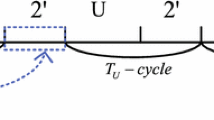Abstract
We consider a multi-access communication channel such as a centrally-controlled polling system, a distributed token-based ring, or a bus network. A message priority-based polling procedure is used to control the access to the channel. This procedure requires the server to have no advance information concerning the number of messages resident at a station prior to its visit to the station. Messages arriving at each station belong to one of two priority classes: class-1 (high priority) and class-2 (low priority). Class-1 messages are served under an exhaustive service discipline, while class-2 messages are served under a limited service discipline. Class-1 messages have non-preemptive priority over class-2 messages resident at the same station. Using a fully symmetric system model, an exact expression for the sum of the mean waiting times of class-1 and class-2 messages is first derived. Upper and lower bounds for the mean message waiting times for each individual message class are then obtained.
Similar content being viewed by others
References
O.J. Boxma and W.P. Groenendijk, Pseudo-conservation laws in cyclic-service systems, J. Appl. Prob. 24(1987).
J.W. Cohen,The Single Server Queue, revised edition (North-Holland, Amsterdam, 1982).
S.W. Fuhrmann, Symmetric queues served in cyclic order, Oper. Res. Lett. 4(1985)139–144.
S.W. Fuhrmann and R.B. Cooper, Stochastic decompositions in the M/G/1 queue with generalized vacations, Oper. Res. 33(1985)1117–1129.
J. Gianini and D. Manfield, An analysis of symmetric polling systems with two priority classes, Perform. Eval. 8(1988)93–115.
D. Gross and C.M. Harris,Fundamentals of Queueing Theory, 2nd ed. (Wiley, New York, 1985).
P.J. Kuehn, Multiqueue systems with nonexhaustive cyclic service, Bell Syst. Tech. J. (1979).
H. Levy and M. Sidi, Polling systems: Application, modeling and optimization, IEEE Trans. Commun. COM-38(1990)1750–1760.
H. Takagi,Analysis of Polling Systems (MIT Press, 1986).
H. Takagi, Queueing analysis of polling models, ACM Comput. Surveys 20(1988)5–28.
H. Takagi, Mean message waiting times in symmetric multi-queue systems with cyclic service, Perform. Eval. 5(1985)271–277.
Author information
Authors and Affiliations
Additional information
This work was supported by NFS Grant No. NCR-8914690, Pacific-Bell and MICRO Grant No. 90-135 and US West Contract No. D890701.
Rights and permissions
About this article
Cite this article
Tsai, Z., Rubin, I. Mean delay analysis for a message priority-based polling scheme. Queueing Syst 11, 223–240 (1992). https://doi.org/10.1007/BF01164003
Received:
Revised:
Issue Date:
DOI: https://doi.org/10.1007/BF01164003




